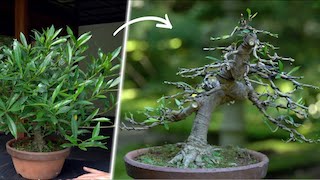Gardenia Bonsai Care guidelines
The Gardenia likes a warm, airy place and much light but no strong direct sunlight. Ideal temperatures for this species are between 16° C and 23° C / 60° F and 75° F and not below 15° C / 59° F in winter. If the windows are opened for ventilation in winter, take care that the Gardenia tree is not exposed to cold draught.
The Gardenia is an acid-loving plant like the Azalea. It should be preferably watered with rain water. Keep the soil slightly moist, but don't over-water the Gardenia. It likes high humidity and benefits from regular spraying with lime-free water if it is kept indoors. Continue reading about watering Bonsai trees.
Watering
Free lecture from the Beginners CourseUse liquid fertilizer for acid-loving plants every two weeks from spring to autumn and once a month in winter, regarding the dosing instruction. The Gardenia is prone to chlororis, so consider to use an additional product to prevent this.
Prune the Gardenia after flowering. Remove the withered flowers if no fruits are developing. The best time for wiring the branches and twigs is in May and June when the plant is more flexible than in other months. Continue reading about pruning Bonsai trees.
Repot every two or three years in spring with gentle root-pruning. Use a soil that is suitable for acid-loving plants like Azaleas, Kanuma for example. Continue reading about repotting Bonsai trees.
The Gardenia can easily be propagated from cuttings which even root in a glass of water.
Aphids, scale and mealy bugs like to attack the Gardenia's leaves and even their roots, and sooty mold thrives on the honey dew those insects produce. Use specific insecticides in case of an infestation. For more detailed information on these techniques, check out our Bonsai tree care section.

Cape jasmine or Jasmin Bonsai (Gardenia jasminoides)
General information about the Jasmin Bonsai tree
The Gardenia (Cape Jasmine, or Jasmin Bonsai) is native to tropical regions of Asia and South Africa and in many countries with a temperate climate it is a popular house plant. It can't endure frost. The leaves are dark green, pointed and glossy. The creamy white flowers which appear during the summer can be simple or filled. If they are pollinated, orange fruit can develop which are oval with six ridges which reach from the fruits' bottom to the top and end in six green narrow lobes. Gardenias are sensitive to being moved or touched and changing their location may result in buds falling off. It is best to keep the plant in one good position and move it as little as possible. The flowers shouldn't be touched as this will cause brown stains on the petals. If you need help identifying your tree, take a look at our Bonsai tree identification guide.





